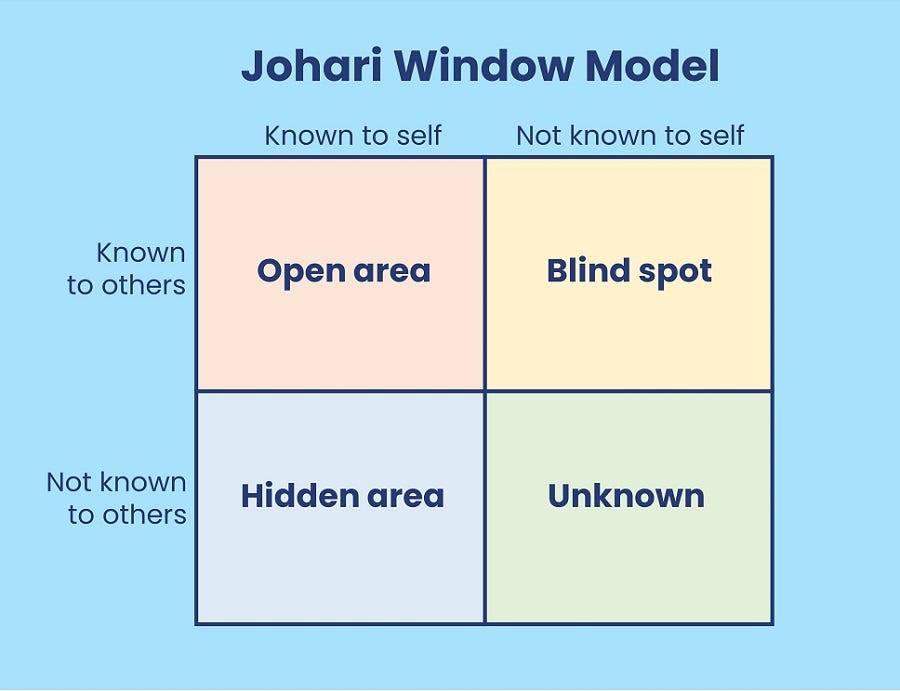Understanding the Johari Window is akin to holding a mirror to one’s psyche, revealing both the known and the unknown facets of the self. Developed by Joseph Luft and Harrington Ingham in the 1950s, this model provides a framework for comprehending how individuals perceive themselves and are perceived by others.
The Johari Window comprises four quadrants: the Open, Hidden, Blind, and Unknown. The Open quadrant represents the aspects of ourselves that we are aware of and are also known to others, fostering transparency and mutual understanding. In contrast, the Hidden quadrant encompasses traits, emotions, or experiences that individuals keep concealed from others, often due to fear of judgment or vulnerability. The Blind quadrant consists of characteristics that others perceive in us, yet of which we may be unaware, highlighting the importance of feedback and self-awareness. Lastly, the Unknown quadrant holds the untapped potential and undiscovered aspects of the self, waiting to be explored through introspection and growth.
The practical applications of the Johari Window are vast and encompass personal development, interpersonal relationships, team dynamics, leadership, and conflict resolution. By expanding the Open quadrant through self-disclosure and seeking feedback, individuals can enhance their self-awareness, build trust, and cultivate deeper connections with others. Moreover, understanding the Blind quadrant can facilitate constructive feedback exchanges, fostering an environment of open communication and mutual respect.
In essence, the Johari Window serves as a powerful tool for self-discovery and personal growth, illuminating the intricate interplay between self-perception and interpersonal dynamics. By embracing the insights offered by this model, individuals can embark on a journey of self-exploration, enriching their lives and relationships along the way.
The Johari Window, comprising four distinct quadrants, each representing different facets of the self, the Johari Window invites individuals to explore the intricacies of their personality and how they interact with others.
The Open quadrant encompasses traits, feelings, and experiences that are known both to oneself and to others. Here lies the realm of transparent communication, where individuals share openly and authentically, fostering trust and understanding. For example, someone who openly expresses their emotions and thoughts in a group setting exhibits a large Open quadrant.
Contrastingly, the Hidden quadrant comprises aspects of the self that are known to the individual but concealed from others. This might include deep-seated fears, insecurities, or past traumas that one chooses to keep private. An illustration could be someone who hides their struggles with anxiety from their friends and family, putting on a façade of confidence.
The Blind quadrant involves traits or behaviours that are visible to others but remain unrecognized by the individual themselves. This could manifest as unconscious biases, habits, or mannerisms that others perceive but of which the person is oblivious. For instance, someone may unknowingly interrupt others in conversation, unaware of the impact on their communication style.
The Unknown quadrant represents aspects of the self that are neither known to the individual nor to others. These could include undiscovered talents, untapped potential, or unexplored emotions waiting to be unearthed through introspection and life experiences.
Understanding the Johari Window and its four quadrants provides individuals with a roadmap for self-discovery and personal growth, encouraging open communication, feedback, and introspection. By exploring each quadrant, individuals can expand their self-awareness, deepen their relationships, and unlock their full potential.
The Johari Window holds immense relevance for students in both their personal and academic lives, offering a transformative lens through which they can navigate relationships, communication, and self-discovery. At its core, the Johari Window fosters self-awareness, a foundational skill crucial for students’ holistic development.
In the realm of academia, the Johari Window serves as a toolkit for students to understand their learning styles, strengths, and areas for improvement. By recognizing their Open quadrant—where their talents and capabilities are known to both themselves and others—students can harness their strengths and seek opportunities for growth. Furthermore, the Hidden quadrant unveils personal barriers and insecurities that may hinder academic progress, encouraging students to confront and overcome challenges with resilience and support.
Beyond the classroom, the Johari Window facilitates deeper connections and empathy within student communities. Through understanding the Blind quadrant—where others may perceive aspects of oneself that are unknown—the Johari Window prompts students to actively seek feedback and engage in reflective dialogue. By embracing constructive criticism and acknowledging differing perspectives, students cultivate a culture of mutual respect and collaboration, essential for fostering inclusive and supportive environments.
Moreover, the Johari Window equips students with essential interpersonal skills vital for navigating social dynamics and building meaningful relationships. By expanding their Open quadrant and reducing blind spots through honest communication and feedback, students enhance their ability to empathize with others, resolve conflicts constructively, and cultivate trust and authenticity in their interactions.
Ultimately, the Johari Window empowers students to become active participants in their personal and academic journeys, guiding them towards self-discovery, growth, and fulfilling relationships. By embracing the principles of transparency, self-reflection, and open communication, students can unlock their full potential and thrive both inside and outside the classroom.
The Johari Window offers a multifaceted approach to personal and interpersonal development, providing students with invaluable tools for navigating various aspects of their lives.
Personal Growth: Utilizing the Johari Window, students can embark on a journey of self-discovery by identifying their strengths, weaknesses, and areas for personal growth. By reflecting on their Open quadrant—where their known qualities reside—and exploring their Hidden quadrant—where personal insights lie—they can gain a deeper understanding of themselves, paving the way for self-improvement and fulfilment.
Building Relationships: Understanding the Johari Window enables students to cultivate healthier and more meaningful relationships. By expanding their Open quadrant through transparent communication and self-disclosure, students foster trust and authenticity in their interactions with peers, teachers, and family members. Moreover, acknowledging and addressing blind spots enhances empathy and understanding, strengthening the foundations of interpersonal connections.
Conflict Resolution: The Johari Window serves as a valuable tool for resolving conflicts by facilitating improved communication and understanding between parties. By recognizing the Blind quadrant—where misunderstandings and differing perspectives may arise—students can engage in constructive dialogue, seek clarification, and empathize with others’ viewpoints, leading to effective conflict resolution and strengthened relationships.
Feedback: Encouraging students to seek and provide constructive feedback fosters personal and professional growth. By actively soliciting feedback, students expand their Open quadrant, gaining valuable insights into their strengths and areas for development. Simultaneously, offering feedback to others promotes mutual understanding and trust, reducing blind spots and enhancing interpersonal dynamics.
Career Development: Self-awareness cultivated through the Johari Window is instrumental in making informed career choices and developing essential skills for future professions. By identifying their strengths, interests, and values, students can align their career aspirations with their personal attributes, maximizing their potential for success and satisfaction in their chosen fields.
Implementing the Johari Window model into daily life, including professional platforms like resumes and LinkedIn, can significantly enhance self-awareness and communication skills. Here are some practical tips and exercises for students:
Self-Reflection Exercises:
Set aside regular time for self-reflection to assess your strengths, weaknesses, and areas for growth.
Journaling prompts: Reflect on past experiences, feedback received, and personal goals to gain insights into your self-perception.
Feedback Solicitation:
Actively seek feedback from peers, mentors, and supervisors to uncover blind spots and expand your Open quadrant.
Use specific questions such as “What are my strengths in teamwork?” or “How can I improve my communication skills?” to elicit meaningful feedback.
LinkedIn Profile Enhancement:
Update your LinkedIn profile with a comprehensive summary that highlights your skills, experiences, and accomplishments (Open quadrant).
Request recommendations from colleagues or supervisors to showcase your abilities and strengthen your professional image.
Resume Development:
Tailor your resume to reflect your strengths and experiences relevant to the job or industry you’re targeting.
Use action verbs and quantifiable achievements to showcase your capabilities and accomplishments (Open quadrant).
To sum up the Johari Window, devised by Luft and Ingham, delineates self-awareness into four quadrants: Open, Hidden, Blind, and Unknown. It’s instrumental for students, aiding personal growth, relationship building, conflict resolution, feedback solicitation, and career development. Practical tips encompass self-reflection, feedback solicitation, LinkedIn profile enhancement, and resume development. By integrating the Johari Window into daily life, students can enhance their self-awareness, communication skills, and overall success.





